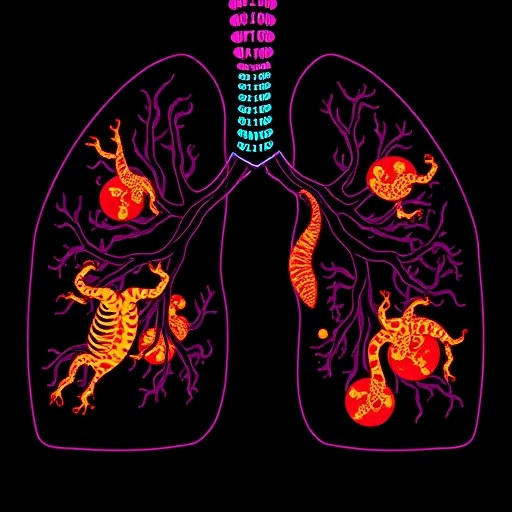Normal skin contains a patchwork of mutated cells, yet very few go on to eventually form cancer and scientists have now uncovered the reason why. Researchers at the Wellcome Sanger Institute and MRC Cancer Unit, University of Cambridge genetically engineered mice to show that mutant cells in skin tissue compete with each other, with only the fittest surviving.
The results, published today (27 September) in Cell Stem Cell suggest that normal skin in humans is more resilient to cancer than previously thought and can still function while a battle between mutated cells takes place in the tissue.
Non-melanoma skin cancer in humans includes two main types: basal cell skin cancer and squamous cell skin cancer, both of which develop in areas of the skin that have been exposed to the sun. Basal cell skin cancer is the most common type of skin cancer, whereas squamous cell skin cancer is generally faster growing. There are over 140,000 new cases of non-melanoma skin cancer each year in the UK*.
However, every person who has been exposed to sunlight carries many mutated cells in their skin, and only very few of these may develop into tumours. The reasons for this are not well understood.
For the first time, researchers have shown that mutated cells in the skin grow to form clones that compete against each other. Many mutant clones are lost from the tissue in this competition, which resembles the selection of species that occurs in evolution. Meanwhile, the skin tissue is resilient and functions normally while being taken over by competing mutant cells.
Professor Phil Jones, lead author from the Wellcome Sanger Institute and MRC Cancer Unit, University of Cambridge, said: "In humans, we see a patchwork of mutated skin cells that can expand enormously to cover several millimetres of tissue. But why doesn't this always form cancer? Our bodies are the scene of an evolutionary battlefield. Competing mutants continually fight for space in our skin, where only the fittest survive."
In the study, scientists used mice to model the mutated cells seen in human skin. Researchers focussed on the p53 gene, a key driver in non-melanoma skin cancers.
The team created a genetic 'switch', which when turned on, replaced p53 with the identical gene including the equivalent of a single letter base change (like a typo in a word). This changed the p53 protein and gave mutant cells an advantage over their neighbours. The mutated cells grew rapidly, spread and took over the skin tissue, which became thicker in appearance. However, after six months the skin returned to normal and there was no visual difference between normal skin and mutant skin.
The team then investigated the role of sun exposure on skin cell mutations. Researchers shone very low doses of ultraviolet light (below sunburn level) onto mice with mutated p53. The mutated cells grew much faster, reaching the level of growth seen at six months in non-UV radiated clones in only a few weeks. However, despite the faster growth, cancer did still not form after nine months of exposure.
Dr Kasumi Murai, joint first author from the Wellcome Sanger Institute, said: "We did not observe a single mutant colony of skin cells take over enough to cause cancer, even after exposure to ultraviolet light. Exposure to sunlight continually created new mutations that outcompeted the p53 mutations. We found the skin looked completely normal after we shone UV light on the mice, indicating that tissues are incredibly well-designed to tolerate these mutations and still function."
Dr Ben Hall, senior author from the MRC Cancer Unit, University of Cambridge said: "The reason that people get non-melanoma skin cancer is because so much of their skin has been colonised by competing mutant cells over time. This study shows that the more we are exposed to sunlight, the more it drives new mutations and competition in our skin. Eventually the surviving mutation may evolve into a cancer."
###
Notes to Editors:
*Non-melanoma skin cancer statistics taken from CRUK: https://www.cancerresearchuk.org/health-professional/cancer-statistics/statistics-by-cancer-type/non-melanoma-skin-cancer#heading-Zero
Publication:
Kasumi Murai et al. (2018) Epidermal tissue adapts to restrain progenitors carrying clonal p53 mutations. Cell Stem Cell. DOI: 10.1016/j.stem.2018.08.017
Funding:
This research was supported by the Medical Research Council and Wellcome.
Selected websites:
About the Medical Research Council Cancer Unit:
The Medical Research Council (MRC) Cancer Unit undertakes world-leading research into the earliest steps in cancer development that can be translated into clinical practice to improve the diagnosis and treatment of cancers. Its research programmes encompass a range of areas including the BRCA2-related forms of inherited cancers and the role of genomic instability in cancer progression, linkages between cancer and metabolism, cancer stem cells, the role of the tumour microenvironment in cancer development and cancer of the oesophagus. The Unit is based on the Cambridge Biomedical Campus, and is part of the University of Cambridge. http://www.mrc-cu.cam.ac.uk
About the Medical Research Council:
The Medical Research Council has been at the forefront of scientific discovery to improve human health. Founded in 1913 to tackle tuberculosis, the MRC now invests taxpayers' money in some of the best medical research in the world across every area of health. Twenty-two MRC-funded researchers have won Nobel prizes in a wide range of disciplines, and MRC scientists have been behind such diverse discoveries as vitamins, the structure of DNA and the link between smoking and cancer, as well as achievements such as pioneering the use of randomised controlled trials, the invention of MRI scanning, and the development of a group of antibodies used in the making of some of the most successful drugs ever developed. Today, MRC-funded scientists tackle some of the greatest health problems facing humanity in the 21st century, from the rising tide of chronic diseases associated with ageing to the threats posed by rapidly mutating micro-organisms. http://www.mrc.ac.uk
About the University of Cambridge
The mission of the University of Cambridge is to contribute to society through the pursuit of education, learning and research at the highest international levels of excellence. To date, 98 affiliates of the University have won the Nobel Prize. Founded in 1209, the University comprises 31 autonomous Colleges, which admit undergraduates and provide small-group tuition, and 150 departments, faculties and institutions. Cambridge is a global university. Its 19,000 student body includes 3,700 international students from 120 countries. Cambridge researchers collaborate with colleagues worldwide, and the University has established larger-scale partnerships in Asia, Africa and America. The University sits at the heart of the 'Cambridge cluster', which employs 60,000 people and has in excess of £12 billion in turnover generated annually by the 4,700 knowledge-intensive firms in and around the city. The city publishes 341 patents per 100,000 residents. http://www.cam.ac.uk
The Wellcome Sanger Institute
The Wellcome Sanger Institute is one of the world's leading genome centres. Through its ability to conduct research at scale, it is able to engage in bold and long-term exploratory projects that are designed to influence and empower medical science globally. Institute research findings, generated through its own research programmes and through its leading role in international consortia, are being used to develop new diagnostics and treatments for human disease. To celebrate its 25th year in 2018, the Institute is sequencing 25 new genomes of species in the UK. Find out more at http://www.sanger.ac.uk or follow @sangerinstitute
Wellcome
Wellcome exists to improve health for everyone by helping great ideas to thrive. We're a global charitable foundation, both politically and financially independent. We support scientists and researchers, take on big problems, fuel imaginations and spark debate. http://www.wellcome.ac.uk
Media Contact
Emily Mobley
[email protected]
01-223-496-851
@sangerinstitute
http://www.sanger.ac.uk
http://dx.doi.org/10.1016/j.stem.2018.08.017




